|
|
|
Sort Order |
|
|
|
Items / Page
|
|
|
|
|
|
|
| Srl | Item |
| 1 |
ID:
145695
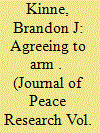

|
|
|
|
|
| Summary/Abstract |
This article assesses the impact of a new form of defense cooperation – formal weapons cooperation agreements, or WCAs – on the global arms trade. WCAs are bilateral framework agreements that establish comprehensive guidelines on the development, production, and exchange of conventional arms. Substantively, WCAs regulate such core areas as procurement and contracting, defense-based research and development, and defense industrial cooperation. These agreements have proliferated dramatically since the mid-1990s. They now number nearly 700, with 30–40 new WCAs signed each year. Newly collected data are used to analyze the effect of WCAs on import and export of conventional weapons. To control for interdependencies in the formation of WCAs, and to account for the mutually endogenous relationship between WCAs and weapons flows, WCAs are modeled as an interdependent network that coevolves with the individual-level arms trade activity of states. The analysis shows that, over the 1995–2010 period, WCAs have significantly increased weapons flows.
|
|
|
|
|
|
|
|
|
|
|
|
|
|
|
|
| 2 |
ID:
172339
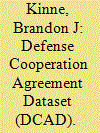

|
|
|
|
|
| Summary/Abstract |
The academic study of defense cooperation focuses heavily on formal military alliances. Yet, governments rarely sign new alliances, and the global alliance structure has remained relatively static for decades. By contrast, governments are increasingly active in defense cooperation agreements (DCAs). These bilateral framework treaties institutionalize their signatories’ day-to-day defense relations, facilitating such wide-ranging activities as defense policy coordination, joint research and development, weapons production and arms trade, joint military exercises, training and exchange programs, peacekeeping, and information exchange. Nearly 2,000 DCAs have been signed since 1980. Preliminary evidence suggests that DCAs impact numerous security, military, and defense outcomes and that governments increasingly incorporate DCAs as core elements of their security strategies. This article introduces the new DCA Dataset (DCAD). I provide a brief historical background on DCAs and compare them to other commonly studied forms of defense cooperation. I then explain coding standards and describe the data set in detail. Finally, I illustrate applications of DCAD to militarized interstate disputes and arms trade.
|
|
|
|
|
|
|
|
|
|
|
|
|
|
|
|
| 3 |
ID:
156479
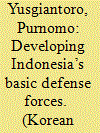

|
|
|
|
|
| Summary/Abstract |
The national resources of Indonesia have a major influence in developing the
nation’s basic defense forces. The state’s capacity to provide budgetary and human
resources is a major determining factor in building the nation’s basic defense
forces. Indonesia is currently not able to leapfrog into the development of ideal
defense forces directly due to constraints on national resources. Thus, the first
step is to focus on developing basic defense forces until the national resources
are sufficiently able to support the development of ideal defense forces. Basic
defense forces should be able to counteract not only fundamental threats (e.g. open
warfare), but also increasingly non-traditional threats, current and potential, to the
nation. An assessment of these non-traditional threats, namely terrorism, cyber
attacks, maritime security and internal disturbances, is important in order to design
basic defense forces, and it begins with a look at the dynamics of the strategic
environment that results in changes in the shape and spectrum of threats.
A key geopolitical concern is that the development of basic defense forces
is not meant to bring the region into an arms race situation. Rather, pursuing
multilateralism and building regional security architecture through international
bodies such as ASEAN are crucial to designing basic defense forces to successfully
eliminate non-traditional threats, as these are increasingly racing to the forefront
of not just national, but also regional, security concerns. This paper will explore
how Indonesia builds its basic defense forces with a focus on countering common
non-threat traditional threats. In order to build basic defense forces, the strategic
environment, the state’s budgetary constraints, the progress of regional defense
cooperation and the anatomy of common threats must be understood first.
|
|
|
|
|
|
|
|
|
|
|
|
|
|
|
|
| 4 |
ID:
191916


|
|
|
|
|
| Summary/Abstract |
How do states distribute the burdens of collective defense? This paper develops a network theory of burden sharing. We focus on bilateral defense cooperation agreements (DCAs), which promote cooperation in a variety of defense, military, and security issue areas. Using a computational model, we show that DCA partners’ defense spending depends on the network structure of their agreements. In bilateral terms, DCAs increase defense spending by committing states to defense activities and allowing partners to reciprocally punish free riding. However, as a state's local network of defense partnerships grows more densely connected, with many transitive “friend of a friend” relations, DCAs have the countervailing effect of reducing defense spending. The more deeply integrated states are in bilateral defense networks, the less they spend on defense. We distinguish two potential mechanisms behind this effect—one based on efficiency improvements, the other on free riding. An empirical analysis using multilevel inferential network models points more to efficiency than to free riding. Defense networks reduce defense spending, and they do so by allowing countries to produce security more efficiently.
|
|
|
|
|
|
|
|
|
|
|
|
|
|
|
|
| 5 |
ID:
182639


|
|
|
|
|
| Summary/Abstract |
Long-range conventional precision strike (LRS) has become a capability that even small, non-allied, but militarily advanced states such as Finland and Sweden can develop. The reasons for developing LRS are myriad, and, while they help solve some tactical and operational challenges brought on by developments in military technology, the capability also has implications for security policy and deterrence. In Finland’s case, LRS contributes to its national deterrence-by-denial approach and enables it to hold military targets deep in adversary territory at risk. An understanding of why Sweden—not a NATO member but equally concerned with capabilities developed by Russia—is only now developing LRS provides some insight into how LRS can contribute to a small state’s defense capabilities and deterrence.
|
|
|
|
|
|
|
|
|
|
|
|
|
|
|
|
| 6 |
ID:
187317
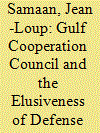

|
|
|
|
|
| Summary/Abstract |
The 2017–21 blockade of Qatar has frequently been depicted as the largest obstacle to further cooperation within the Gulf Cooperation Council. However, this narrative overestimates the impact of the dispute and underestimates the historical limitations of the GCC and its multilateral projects prior to the crisis. GCC initiatives rarely produced tangible results, even before 2017, because their primary function was at the rhetorical level for Gulf Arab rulers, providing them with narratives of apparent regional unity rather than with concrete instruments of cooperation.
|
|
|
|
|
|
|
|
|
|
|
|
|
|
|
|
| 7 |
ID:
125967
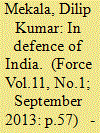

|
|
|
|
|
| Publication |
2013.
|
| Summary/Abstract |
Despite the falling rupee, which might affect defence spending for some time, Lockheed Martin remains surprisingly optimistic about defence and homeland security business in the country. Not just that, it has already started looking for potential partners from the private sector. "The economics here are not troubling us," said Susan Maraghy, regional vice president for South Asia, Corporate International Business Development, Lockheed Martin Corporation.
|
|
|
|
|
|
|
|
|
|
|
|
|
|
|
|
| 8 |
ID:
125123
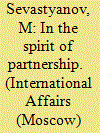

|
|
|
|
|
| Publication |
2013.
|
| Summary/Abstract |
ON JUNE 5, 2013, Belarusian capital Minsk hosted the 64th regular meeting of the Council of the Commonwealth of Independent States defense ministers chaired by Russian Defense Minister Sergey Shoigu.
The meeting was attended by delegates of the defense ministries of Azerbaijan, Armenia, Belarus, Kazakhstan, Kyrgyzstan, Moldova, Russia, Tajikistan, Uzbekistan, and Ukraine, as well as by delegates of the CIS Executive Committee, the Secretariat of the CIS Council of Defense Ministers and the Committee of the CIS Heads of State Council for the Affairs of Warriors-Internationalists..
|
|
|
|
|
|
|
|
|
|
|
|
|
|
|
|
| 9 |
ID:
123678
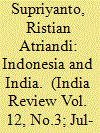

|
|
|
|
|
| Publication |
2013.
|
| Summary/Abstract |
Despite their shared historical and cultural affinities, the bilateral relationship between India and Indonesia is perhaps the least explored, researched, and developed among all the bilateral relations both countries have forged. This is particularly so in the field of defense, despite both countries being Indian Ocean littoral neighbors with only 80 nautical miles between Indonesia's westernmost province of Aceh and India's southernmost Indira Point in the Great Nicobar Island. Both countries have large Muslim populations and share common democratic values. These factors should both be ingredients and incentives to warrant closer defense cooperation. Why then do they seem embroiled in mutual neglect? 1
|
|
|
|
|
|
|
|
|
|
|
|
|
|
|
|
| 10 |
ID:
145442
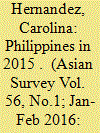

|
|
|
|
|
| Summary/Abstract |
Other than the South China Sea (SCS) disputes, the Philippines in 2015 faced the same conditions as in 1996: keeping a sustainable peace in Mindanao, presidential elections, and a promising economy. The year was capped by the country’s hosting of the Asia Pacific Economic Cooperation (APEC) Summit. Chinese assertiveness challenged ASEAN’s unity and made closer Philippine ties to Washington and Tokyo an imperative.
|
|
|
|
|
|
|
|
|
|
|
|
|
|
|
|
|
|
|
|
|